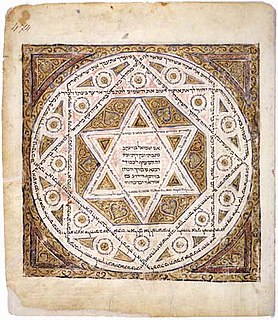 W
WThe Alba Bible is a 1430 illuminated manuscript translation of the Old Testament made directly from Hebrew into Mediaeval Castilian. The translation was carried out under the direction of Moses Arragel, rabbi of the Jewish community of Maqueda in the Spanish province of Toledo, at the behest of Don Luis de Guzmán, Grand Master of the military-religious Order of Calatrava.
 W
WThe Birds' Head Haggadah is the oldest surviving illuminated Ashkenazi Passover Haggadah. The manuscript, produced in the Upper Rhine region of Southern Germany in the early 14th century, contains the full Hebrew text of the Haggadah, a ritual text recounting the story of Passover – the liberation of the Israelites from slavery in ancient Egypt – which is recited by participants at a Passover Seder. The text is executed in block calligraphy and accompanied by colorful illustrations of Jews performing the Seder practices and reenacting Jewish historical events. The Birds' Head Haggadah is so called because all Jewish men, women, and children depicted in the manuscript have human bodies with the faces and beaks of birds. Non-Jewish and non-human faces are blank or blurred. Numerous theories have been advanced to explain the unusual iconography, usually tied to Jewish aniconism. The Haggadah is in the possession of the Israel Museum in Jerusalem, where it is on permanent exhibition.
 W
WThe Cloisters Hebrew Bible is a Hebrew Bible codex made in the Kingdom of Castile from the early to mid-14th century, with an approximate date prior to 1366. The Metropolitan Museum of Art acquired this manuscript from the collection of Jacqui Safra from Sothebys Judaica auction in December 20, 2017.
 W
WThe Golden Haggadah is an illuminated Hebrew manuscript originating around c. 1320-1330 in Catalonia. It is an example of an Illustrated Haggadah, a religious text for Jewish Passover. It contains many lavish illustrations in the High Gothic style with Italianate influence, and is perhaps one of the most distinguished illustrated manuscripts created in Spain. The Golden Haggadah is now in the British Library and can be fully viewed as part of their Digitized Manuscript Collection MS 27210.
 W
WThe Leningrad Codex is the oldest complete manuscript of the Hebrew Bible in Hebrew, using the Masoretic Text and Tiberian vocalization. According to its colophon, it was made in Cairo in 1008 CE. There are older manuscripts of translations into other languages, such as the 4th-century Codex Vaticanus in Greek.
 W
WThe North French Hebrew Miscellany or "French Miscellany" or "London Miscellany" is an important Hebrew illuminated manuscript from 13th-century France, created c. 1278-98. A miscellany is a manuscript containing texts of different types and by different authors, and this volume contains a wide range of Hebrew language texts, mostly religious but many secular. The manuscript is exceptional among medieval Hebrew manuscripts both for its size and the diversity of the texts and the quality and lavishness of its illuminations, which as was often the case were added by Christian specialists.
 W
WThe Sarajevo Haggadah is an illuminated manuscript that contains the illustrated traditional text of the Passover Haggadah which accompanies the Passover Seder. It is one of the oldest Sephardic Haggadahs in the world, originating in Barcelona around 1350. The Haggadah is owned by the National Museum of Bosnia and Herzegovina in Sarajevo. Its monetary value is undetermined, but a museum in Spain required that it be insured for $7 million before it could be transported to an exhibition there in 1992.
 W
WThe Szyk Haggadah is a Passover Haggadah that was illustrated by the Polish-Jewish artist Arthur Szyk in Poland between 1934 and 1936. Szyk's visual commentary on the ancient story of Passover uses the vocabulary and format of an illuminated manuscript; each of his 48 full-page watercolor and gouache illuminations contains the traditional text of the Haggadah, which is clarified and interpreted by the images and symbols on the same page.
 W
WThe Washington Haggadah is a Hebrew-language illuminated manuscript haggadah created by Joel ben Simeon in 1478. He was a specialist illuminator of haggadot, who seems to have worked in both Italy and Germany, and whose style shows influences from the contemporary art of both countries.